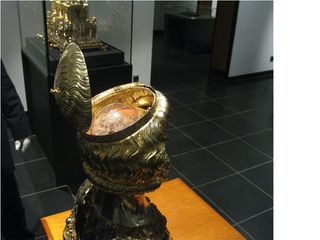Charlemagne's Bones Are Likely Authentic, Scientists Say

The relics of Charlemagne, long on display at a treasury in Germany, are likely the real bones of the Frankish king, scientists say.
Last Tuesday (Jan. 28) marked exactly 1,200 years since Charlemagne died in A.D. 814. To commemorate the occasion, a group of scientists at the Cathedral of Aachen gave a summary of the research that has been conducted on the king's bones, stretching back to 1988.
Like many saints whose body parts were scattered in various reliquaries, Charlemagne was not left to rest in one piece. (Charlemagne was actually canonized by the "antipope" Paschal III in the 12th century, though the Holy See rejected his sainthood.) Today, the vast majority of the king's bones belong to the treasury at the Cathedral of Aachen in western Germany, said Frank Rühli, who heads the Centre for Evolutionary Medicine at the University of Zurich.
Pieces of the king
Part of Charlemagne's skull is kept in a bejeweled bust, intricately decorated with gold and silver, at Aachen. The church — which was built as Charlemagne's Palatine Chapel and is now a UNESCO World Heritage site — is also home to relics of the king's arm and leg bones, as well as a marble sarcophagus containing most of the body. Smaller bits Charlemagne's skeleton may have been distributed elsewhere over the centuries; a 14th-century church in Prague even lays claim to some of Charlemagne's teeth. [Religious Mysteries: 8 Alleged Relics of Jesus]
Though there's no way for scientists to authenticate the bones definitively, the fragments at Aachen examined by scientists over the past 26 years, point to a match with Charlemagne.
"The evidence is that the isolated bones fit the ones in the sarcophagus, also that they belong to an older male individual," Rühli said in an email to LiveScience.
Sign up for the Live Science daily newsletter now
Get the world’s most fascinating discoveries delivered straight to your inbox.
"There is always doubt about this kind of bones, still I am quite sure (but not 100%) that they may belong to him," Rühli wrote.
A tall old man
Sometimes called the "Father of Europe," Charlemagne stabilized much of mainland Europe after a long period of decline following the late fifth-century breakup of the Roman Empire. Besides being a great military leader, he ushered in the Carolignian Renaissance, a cultural revival marked by a boom in the arts and education reform. Charlemagne became the first Holy Roman Emperor when he was crowned by Pope Leo III on Christmas Day in A.D. 800.
Though he was the son of "Pippin the Short," Charlemagne was said to have an impressive physique. Rühli was involved in a study of the king's tibia in 2010, published in the journal Economics and Human Biology, finding that Charlemagne would have stood about 6 feet (1.84 meters) tall, towering over 98 percent of the population of his day.
Charlemagne was in his 70s when he died, and Rühli and colleagues say the bones belonged to an older man. Historical records (like the biography written by Charlemagne's courtier Einhard) indicate that the king may have walked with a limp in old age, and scientists did indeed find bony deposits on the kneecap and heel bone. Though it was thought that the king died of pneumonia, researchers have found no evidence for the disease in Charlemagne's bones.
No further tests have yet been planned on Charlemagne's skeleton, Rühli said, though a news release about the scientists' summary noted that a DNA analysis might eventually help confirm that the bones in the known reliquaries belong to one person.
Follow Megan Gannon on Twitter and Google+. Follow us @livescience, Facebook & Google+. Original article on Live Science.

Most Popular


